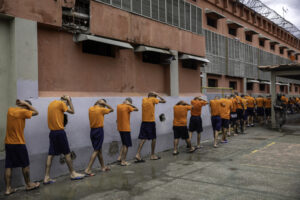By Adriana Beltrán, Senior Associate for Citizen Security and Ashley Davis, Program Assistant
In February of 2012, Honduras made international headlines when a deadly fire broke out in one of the country’s prisons and killed over 300 inmates who had remained trapped in their cells. Investigations later confirmed that not only had the prison been severely overcrowded and lacking sanitary and safe conditions, but the infrastructure of the facility was structurally unsound and the prison staff lacked sufficient training to respond to the crisis. Equally worrisome was the fact that over half of the inmates had not yet been convicted of any crime—they had been locked up, awaiting a trial. Issues such as these are not unique to Honduras, and are serious problems affecting many penitentiary systems throughout Latin America.[1]
In recent decades, the prison population in Latin America has been growing steadily; harsh drug and anti-gang laws have led to a massive expansion of the prison population, causing systemic overcrowding in underfunded and often neglected penitentiary systems. In some cases, such as in El Salvador, the number of people behind bars exceeds the capacity of the prisons by over 320 percent. The majority of prisoners have yet to be tried and many wait years for a hearing. In some countries, gangs continue to operate and recruit new members inside the prisons, and gang leaders orchestrate extortion and homicides from behind bars.
Once freed from prison, there are few programs that help former inmates reintegrate back into society. In many countries throughout the region, limited resources are allocated to provide the education, training, and services to help prisoners gain employment and obtain some degree of emotional and financial stability.
Unfortunately, the many problems plaguing the penitentiary systems in Latin America have received little attention, both by the Latin American governments and international donors alike. Not surprisingly, the issue of prison reform and reintegration is often not high on governments’ priority list nor is it an issue that wins significant public support, even though the prison system is a key component of criminal justice systems and its ability to reduce crime and recidivism.
Nevertheless, there are some encouraging efforts being pursued in the region. In June of 2014, WOLA’s Citizen Security team invited a delegation of experts to visit the prison system in Costa Rica. The delegation included representatives from Chile, Mexico, El Salvador, Honduras, Costa Rica, and the United States. In addition to visiting the women’s prison in San José, the delegation met with the current and former Minister of Justice and Peace, the Acting Director and staff of the penitentiary system, the head of the Social Reinsertion Program within the Ministry of Justice, a penal implementation judge, the head of Costa Rica’s Anti-Torture Mechanism, the UN Latin American Institute for the Prevention of Crime and the Treatment of Offenders (ILANUD), and civil society organizations.
Costa Rica as a Case Study: Reform from Within
Compared to other countries in the region, crime levels in Costa Rica are comparatively low. In 2009, the country had the lowest homicide rate in Central America (11.6 per 100,000 people). Over the last couple of decades, prisons in Costa Rica have been less crowded, and penitentiary system authorities have been, for the most part, more rehabilitation-orientated than in other countries in the region.
Nonetheless, until recently, crime levels were rising steadily. Public concern about insecurity resulted in a push for tougher crime-control policies, including legislative reforms to increase the country’s maximum prison sentence from 25 to 50 years, and the creation in 2008 of tribunals to speed up trials of individuals arrested while in the act of committing a crime. New drug sentencing laws were also adopted which defined any behavior related to the production and commercialization of illicit drugs as a serious felony regardless of the nature of the crime committed. These laws have disproportionally affected poor and marginalized women and youth. The result was a dramatic increase in the prison population and prison overcrowding. From 2006 to 2012, the prison population increased by more than 50 percent. In early 2013, the country had the third-highest incarceration rate in Central America, after El Salvador and Panama.
In 2013, in recognition of the fact that the state of prison conditions were contributing to the likelihood of recidivism, the Costa Rican government began to implement a series of modest reforms to its prisons and measures to strengthen its reintegration initiatives. These measures included the creation of an external oversight body to protect the rights of individuals in custody, enhanced training of penitentiary system police and staff, and with support from the Inter-American Development Bank (IDB), a plan to expand the country’s reinsertion programs in the prison system in coordination with local businesses. An amendment to the Narcotics Law was also passed to minimize the imprisonment of women in vulnerable situations.
What is most interesting about the process in Costa Rica is that it has been led primarily by reformers within the Ministry of Justice and Peace and the penitentiary system. Both senior and mid-level staff have played a critical role in resisting pressures from policymakers who want to toughen sentencing that would result in an increase of the prison population. At the same time, the officials have drawn on international donor support to protect and expand their reintegration efforts in the penitentiary system. While every situation is different and Costa Rica presents several advantages that other countries may lack, its recent efforts provide an encouraging example of how reform is possible in this politically sensitive issue.
The delegation is part of a project, supported by the Andean Development Bank, to look at how criminal justice reform happens, and how reformers, both inside and outside the system, work to achieve long-term institutional changes that increase citizen security while respecting human rights. WOLA will soon release a report with the project’s observations and conclusions.
[1] For more information, see WOLA and the Transnational Institute’s report, Systems Overload; and Gurises Unidos and Church World Service’s study, Invisible No More.


